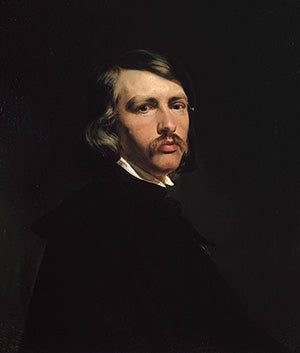This year marks the 100th anniversary of the German-born history painter Emanuel Gottlieb Leutze, whose monumental painting Washington Crossing the Delaware (1851) hangs regally in the Metropolitan Museum of Art and decorates the reverse of the New Jersey State Quarter. Although best known for this and his iconic Westward the Course of Empire (Smithsonian American Art Museum, 1861), commissioned for the Capitol Rotunda, Emanuel Leutze was also a talented portrait painter, and Georgetown owns the artist’s self-portrait, donated to the University in 1957 by Harold Hudson.
 Leutze’s first major commission came in 1836 when he was employed to take likenesses of famous public figures for Longacre and Herring’s National Portrait Gallery of Distinguished Americans. This was followed by two years of itinerant portrait painting in Maryland, Virginia and Pennsylvania. With income generated from sales of his work, Leutze moved back to Germany in 1840 to study at the Dusseldorf Academy, at that time the most famous school of art in Europe. While there, he experienced the German revolutions of 1848-49 and was a strong advocate of its goals of unifying the German states and challenging political systems that had been in place for centuries. To encourage the liberal reformists, he decided to paint the now famous scene from the American Revolution depicting Washington courageously leading his troops across the Delaware River to Trenton, N.J. during the momentous night of December 25th, 1776.
Leutze’s first major commission came in 1836 when he was employed to take likenesses of famous public figures for Longacre and Herring’s National Portrait Gallery of Distinguished Americans. This was followed by two years of itinerant portrait painting in Maryland, Virginia and Pennsylvania. With income generated from sales of his work, Leutze moved back to Germany in 1840 to study at the Dusseldorf Academy, at that time the most famous school of art in Europe. While there, he experienced the German revolutions of 1848-49 and was a strong advocate of its goals of unifying the German states and challenging political systems that had been in place for centuries. To encourage the liberal reformists, he decided to paint the now famous scene from the American Revolution depicting Washington courageously leading his troops across the Delaware River to Trenton, N.J. during the momentous night of December 25th, 1776.
In 1845 the artist met and married Juliane Lottner, daughter of a military officer. He painted her portrait, now at the Staatsgalerie, Stuttgart, early in their marriage.
It is thought that Georgetown’s self-portrait, by far the best likeness Leutze painted of himself, was created around the same time, a common practice in celebration of betrothals and weddings. The portrait is rendered with such skill in naturalism that one can barely detect the lenses of the artist’s spectacles.
LuLen Walker, University Art Collection Curator
September 3, 2016
